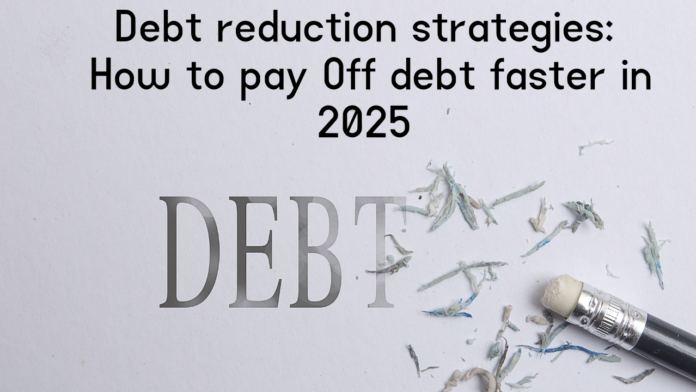Introduction to Debt Reduction
You may feel to be remaring in the shadow of a huge black cloud that always brings bad weather–but even if you can escape from its iron grip, facing bankruptcy is can be less stressful. Now we enter into 2024, it’s high time that you reassert control of your finances and explore ways to reduce debt. If you have the fixed debts of credit card balances and left over loans, the roads to liberation are more jarsly open than you may think.
If you manage your life in this light and take realistic steps in this cosmopolitan scenario, you can speed up the process of discharging your debt while still living a stable and prosperous financial life. Plan achievable measures and routes given the current economic environment. So get ready to convert those thoughts about having done with your debts into deeds.
Creating a Budget and Cutting Expenses
Borrowing right at its source, writes out from home? The logical starting point when formulating an effective way out of the dead end that is debts should always be to draw up a budget. Okay, where does the money go? Melanie Coreless TODAY / TIME where does one put pay of the month go? A nose count or accountant for the twenty-first century, freelancers and for profit electricians have always been working at nearly the same function. Over time plus little gains add up Reasons to balance accounts: without the tools of debt elimination, making a plan obviously becomes easier. It also helps organize record-keeping, allowing you to look at which goals are overlapping others or in conflict with them as to the monthly expenses File a claim on the expense budget – you can check costs pretty much whatever they are Does anyone out there have any better ideas as to how funds can be raised without this or that stricture on them? Achieving goals There is no better opportunity to work hard than when one has to for decades upon end in order to make pocket change. Just keep an account on it, now that is rebate! By every mill Don’t be afraid to take the tougher line The specific goal for your financial life in addition to the amount of debt remaining is to look at both total and per capita living expenditures. Have fun with numbers, as Ed Cole once said.
Prioritizing Debts
Which debts you pay off first can have a major effect on your ability to get a little forward in life. Not all debts are the same. Some have higher interest rates, others are actually the same as other debts but need to be paid back faster. Make a list of all the debts you owe. Then, start from number one. This will be your highest-interest debt–credit card balances probably–and where we take them is where we need to do well in this ranked order for repayment. Working this way will save you money in the long run. However, think about things from another angle. If a series of smaller debts weighs heavily on your mind then paying them off first will give a real sense of achievement and a spring in your step for the future.
Snowball vs Avalanche Method

The choice between Snowball and Avalanche is a potential game-changer for you in terms of how much debt you’ll end up clearing-off.
The Snowball approach deals with the smallest debts first. As you erase these smaller debts one after another, there’s plenty of immediate gratification. That boosts your confidence to continue clearing balances away.
On the other hand, the Avalanche method goes after high-interest loans first. In this way, saving money cranked out slowly over time can soon amount to a much larger figure than you’d have thought possible from compound interest calculations alone.
With merits for both. Should you be the type of person who needs support for small victories and motivation getting started, go Snowball. But if your primary aim is to save money then Avalanche may suit your requirements better. Choose according to what motivates you: immediate satisfaction or long-term savings.
Negotiating with Creditors
Negotiating with your creditors can be an important power tool in the journey out of debt. The majority of people simply don’t realize that often lenders would rather talk than see you default on payments.
Begin by getting accurate information about what you owe and the ways you will have to repay it. Be realistic about what you can afford each month–this will be the baseline for your future right-handed debates with lenders.
In your dealings with a creditor: keep your cool — even if they get high-handed — and explain how finding a compromise between benefits both parties might be possible. One thing you might do is ask for lower interest rates or longer terms on payment.
If your troubles are getting progressively heavier, consider recommending to your creditors that they take an all-cash settlement less than what is owed. So long as the money flows in for them, whether some is lost in the wash doesn’t matter at all because any more could be lost to them. You should always get any agreements in writing before proceeding with new payment arrangements. This way, if there are any disputes later on, you are protected.
Utilizing Balance Transfers and Consolidation Loans

Balance transfers and debt consolidation loans can make your debt reduction strategy more powerful. When you combine many debts into a single lump sum, whose rates are often lower than those of the original collective, this can mean higher payments with lower interest.
The balance transfer takes place when high-interest credit card balances are moved to a new card that has 0% APR for an introductory period. This strategy will allow you to pay off what you owe faster and more easily, giving you room of our own. Just remember to factor in any fees and the terms after promotional period ends.
Consolidation loans are another area where their use can be advantageous. If they’re organized properly, these personal loans pay off your existing debts–so that instead of making fifteen or more payments per month, just one payment every month at potentially lower interest rates takes care of all your bills. It makes it much easier to keep track of payments while increasing your credit score accordingly if used wisely.
Before you go in for one, use a debt payoff calculator to determine how much interest and time these options will save. The tactics you choose must be well-suited to your individual habits and financial goals if they are to create effective results.
Strategies for Staying Motivated and on Track
Ways of staying motivated on your way to financial independence are not without difficulty. One trick that most people find effective is to set a series of clear and attainable goals. Although it may seem like pie in the sky now, if you break down the whole process into smaller steps–such as canceling one credit card bill or crossing a particular point off your balances spreadsheet–it’s not hard.
Your dream might come true! Allowing visual aids to remind you ‘re on the right track can be a great help. Make a chart or use an application to show your progress in icons. Watching those numbers go down can give you the impetus you need to keep plugging away at it.
Where possible, give yourself little treats along the way, each time you reach a milestone. These are probably going to be fairly moderate–after all, it’s not like you just took a million pound profit from your business; but maybe today is some good food and movie with friends.
Or, find a support group and meet with similar-minded people. If you’re somewhat an old-timer with consumer debt version products like us, then there’s a new products board meeting starting up which I bet many wll be interested in.” The experiences and challenges that are bike cycled with a fellow sufferer help give strength, confidence and persistence to people trying together for financial deliverance.
Alternative Options: Bankruptcy or Debt Settlement
Bankruptcy or debt settlement can be an option if you’re unable to meet financial obligations However, how you use these options depends on your particular circumstances.
Bankruptcy is a legal procedure which discharges most unsecured debts. This process allows you to start over only it is seen as major damage to your credit score for many years While understanding the consequences before taking that step is very important.
On the other hand, debt settlement requires you to bargain with creditors on the total amount owed. Though this option can let end up paying less than what you owe ultimately, much negotiation skill or some helpers are needed for it.
Both have their advantages and disadvantages. Bankruptcy could relieve psychological tension speedily, while debt settlement might save part of your credit rating over time Considering how each fits into your objectives is crucial if you want to make an informed choice in dealing with unsustainable debts.
Conclusion and Long-term Financial Planning
When you want to get rid of the debt, you must commit and have good strategies.With each of these means of managing credit, you should keep in mind your long-range financial goals. You can’t just concentrate on short-term prosperity
Some suggestions now can provide the foundation for stability down the line.People learn where their money goes each month by setting budgets. By identifying and eliminating unnecessary expenditures, they are able to allocate more money toward paying off debts. “Bringing greater order and regularity to personal finances will brighten not only the lives of individual families but also the outlook for world economies”
Next, rank your debts, so you’re paying off those with the highest interest rates or smallest balances. This one change—the order in which money gets put back—can make a big difference in how much time you have to endure debt. This is known as snowballing progress through different areas of life. No pain, no gain! But slowly, and with great deliberation (and so it was with my wife and son already sea-swept for years from one abode to another), once one was free of any large short-term financial burdens–in other words, out from under all but reasonable long-term obligations–one might have a decent life finally!
It is often possible to negotiate away some portion of interest or service charges in return for lower monthly payments and improved repayment terms which can hence help to pay off balance faster.If that still does not suffice when debt pressures reach drastic levels then seek relief with more radical action like bankruptcy or debt settlement.
The key is to keep motivated. Track how far you’ve come with pay-off calculators that can graphically illustrate just how much progress you’ve made and what lies ahead. By reviewing your goals at regular intervals, as well keeping abreast of developments in financial markets, you are more likely to stay on track for success.
Going forward, remember to establish healthy money management routines that will prevent new debts piling up on top of the old ones. Furthering your knowledge about personal finance is another way of equipping yourself to act wisely as new opportunities for saving, investing or spending present themselves in future. Financial freedom means not just escape from debt but also freedom from financial worry about your family’s future.


